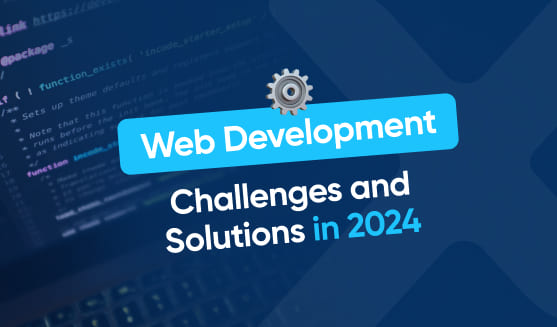
In the fast-paced world of technology, web development is constantly evolving to meet the demands of users and businesses alike. As we look ahead to 2024, it is important to understand the landscape of web development, the challenges that lie ahead, and the innovative solutions that will shape the future of this field.
Understanding the Landscape of Web Development in 2024
The Evolution of Web Development
Web development has come a long way since its inception. From the early days of basic HTML and CSS, we have witnessed the emergence of dynamic websites, interactive user interfaces, and responsive design. In 2024, web development will continue to evolve with new technologies like virtual reality, augmented reality, and 5G connectivity. These advancements will provide developers with new tools and opportunities to create immersive and engaging web experiences.
Imagine a world where you can browse a website and interact with it as if you were physically present. With virtual reality (VR) and augmented reality (AR) technologies becoming more accessible, web developers will be able to create virtual environments and overlay digital information onto the real world. From virtual showrooms that allow customers to try on clothes without leaving their homes to interactive educational experiences that bring history to life, the possibilities are endless.
Key Trends Shaping Web Development in 2024
In addition to technological advancements, there are several key trends that will shape the landscape of web development in 2024. One such trend is the rise of mobile-first design. With more users accessing the internet through mobile devices, developers must prioritize mobile optimization to ensure a seamless user experience. Another trend is the increasing importance of website performance. Users expect fast-loading websites, and developers will need to optimize their code and leverage technologies like browser caching and content delivery networks to meet these expectations.
But it’s not just about speed and responsiveness. In 2024, web developers will also need to focus on creating personalized experiences for users. With the help of artificial intelligence and machine learning, websites will be able to analyze user behavior and preferences to deliver tailored content and recommendations. Imagine visiting an e-commerce website and being shown products that perfectly match your style and interests, or reading a news article that highlights stories that align with your values and beliefs.
Furthermore, privacy and security will continue to be crucial considerations in web development. With the increasing prevalence of cyberattacks and data breaches, developers must implement secure coding practices, use encryption technologies, and regularly update and patch vulnerabilities. Additionally, adherence to standards and accessibility guidelines will become more important than ever, as inclusivity and user experience become top priorities.
As we look ahead to 2024, it’s clear that web development will continue to push boundaries and redefine what is possible on the internet. From immersive virtual experiences to personalized content delivery, developers will play a pivotal role in shaping the future of the web. So, buckle up and get ready for an exciting journey into the ever-evolving landscape of web development!
Major Challenges in Web Development
Dealing with Complexities of New Technologies
As technology continues to advance at a rapid pace, web developers face the challenge of staying updated with the latest tools and frameworks. The adoption of new technologies, such as virtual reality and augmented reality, presents a learning curve for developers. They will need to invest time and effort in mastering these technologies to create cutting-edge web experiences.
Moreover, the evolution of artificial intelligence (AI) and machine learning has introduced new possibilities and complexities in web development. Integrating AI-driven features like chatbots, personalized recommendations, and predictive analytics requires a deep understanding of AI algorithms and data processing techniques. Web developers need to adapt to these advancements to deliver intelligent and user-centric web solutions.
Security Concerns in Web Development
With the increasing sophistication of cyber threats, security is a major challenge in web development. Developers must implement secure coding practices, regularly update software packages, and conduct thorough security audits to protect websites and user data. This includes ensuring proper authentication and authorization mechanisms, implementing secure data transmission protocols, and staying vigilant against emerging threats.
Additionally, the rise of Internet of Things (IoT) devices has expanded the attack surface for cybercriminals, posing new security challenges for web developers. Securing web applications that interact with IoT devices requires a comprehensive approach that addresses device authentication, data encryption, and secure communication protocols. Web developers must stay abreast of IoT security best practices to safeguard against potential vulnerabilities.
The Issue of Cross-Browser Compatibility
Web developers often face the challenge of ensuring their websites function correctly and consistently across multiple browsers and devices. With the vast array of browsers, operating systems, and screen sizes in use today, achieving cross-browser compatibility can be a complex task. Developers must utilize testing tools, responsive design techniques, and progressive enhancement strategies to deliver a seamless experience to all users.
Innovative Solutions for Web Development Challenges
Leveraging Automation in Web Development
To overcome the challenges of complexity and time constraints, automation will play a significant role in web development. Developers can utilize tools like task runners, build systems, and continuous integration/continuous deployment (CI/CD) pipelines to automate repetitive tasks and streamline the development process. This allows developers to focus on higher-level coding and creative problem-solving.
By implementing automation in web development, developers can save valuable time and effort. Task runners, such as Grunt or Gulp, can automate tasks like minifying CSS and JavaScript files, optimizing images, and running tests. This not only speeds up the development process but also ensures consistent and error-free code. Build systems like Webpack or Parcel can bundle and optimize assets, making the website faster and more efficient. Additionally, CI/CD pipelines enable developers to automatically build, test, and deploy their code, reducing the risk of human error and ensuring a smooth and continuous delivery process.
Embracing Progressive Web Applications
Progressive Web Applications (PWAs) are a solution to the challenge of delivering a consistent experience across different devices and platforms. By utilizing modern web capabilities, PWAs offer users offline access, push notifications, and fast loading times, similar to native mobile apps. Developers can leverage service workers and responsive design principles to create PWAs that provide a seamless user experience, regardless of the user’s device or network connection.
One of the key advantages of PWAs is their ability to work offline. By caching the necessary assets, such as HTML, CSS, and JavaScript files, PWAs can still function even when the user is not connected to the internet. This is especially beneficial for users in areas with limited connectivity or when traveling. Additionally, PWAs can send push notifications to users, keeping them engaged and informed even when they are not actively using the application. This feature is particularly useful for e-commerce websites or news platforms. With fast loading times and smooth transitions, PWAs provide a native-like experience, enhancing user satisfaction and increasing conversion rates.
The Role of AI in Web Development
Artificial Intelligence (AI) and machine learning are poised to revolutionize web development in 2024. AI-powered tools can assist developers in automating tasks, generating code, and analyzing data. For example, AI can be used to perform automated testing, generate responsive layouts, and provide personalized user experiences. By harnessing the power of AI, developers can streamline their workflows and deliver more intelligent web solutions.
Imagine a scenario where an AI-powered tool can automatically test a website across different browsers and devices, identifying and fixing compatibility issues. This would save developers countless hours of manual testing and debugging. AI can also generate responsive layouts by analyzing user behavior and adapting the design to fit different screen sizes and resolutions. Furthermore, AI can provide personalized user experiences by analyzing user data and tailoring the content and recommendations based on individual preferences. This level of personalization can significantly enhance user engagement and satisfaction.
Future Predictions for Web Development
The Impact of 5G on Web Development
The rollout of 5G technology will have a significant impact on web development in 2024. With faster download and upload speeds, lower latency, and greater network capacity, 5G will enable developers to create richer and more immersive web experiences. This includes real-time applications, high-definition video streaming, and seamless integration with emerging technologies like augmented reality and Internet of Things (IoT) devices.
The Rise of Serverless Architecture
Serverless architecture is gaining popularity in web development due to its scalability, cost-efficiency, and reduced operational burden. In 2024, we can expect an increased adoption of serverless platforms like AWS Lambda and Azure Functions. Developers can leverage these platforms to build and deploy applications without managing servers, allowing them to focus on writing code and delivering value to end-users.
The Influence of IoT on Web Development
The Internet of Things (IoT) continues to expand, with connected devices becoming more prevalent in our daily lives. In 2024, web developers will need to adapt to the challenges and opportunities presented by IoT. This includes creating web interfaces for IoT devices, leveraging data from sensors and actuators, and ensuring the security of IoT ecosystems. With the growth of IoT, web developers will play a crucial role in enabling seamless connectivity and interaction between devices and users.
In conclusion, web development in 2024 will be shaped by advancements in technology, key trends, and the challenges that developers will face. By understanding the evolving landscape, embracing innovative solutions, and anticipating future predictions, developers can stay ahead of the curve and create web experiences that are both cutting-edge and user-centric. The future of web development is promising, and by overcoming challenges and leveraging opportunities, developers can continue to push the boundaries of what is possible on the web.


